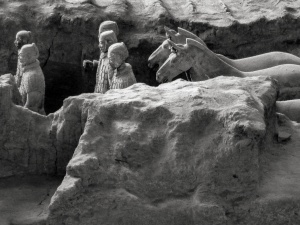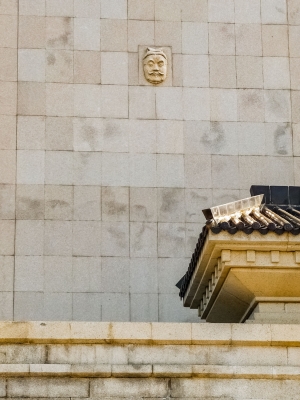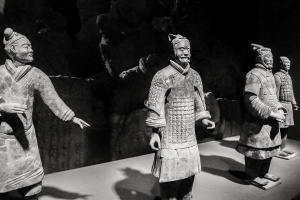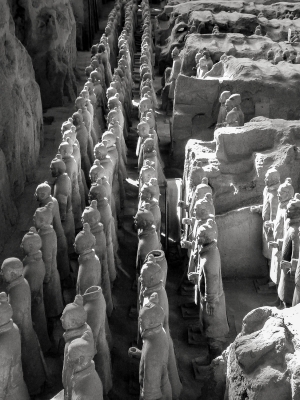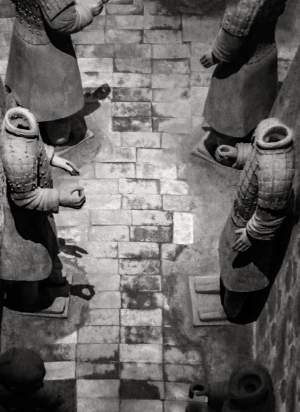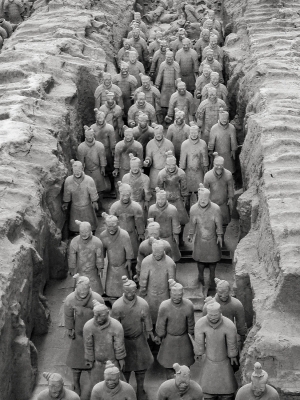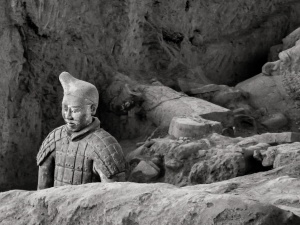The Terracotta Warriors
Ruling a freshly unified China from 221 through to 207 BCE, Emperor Qin Shi Huangdi would oversee a multitude of substantial building projects during his lifetime. The construction of the earliest version of the Great Wall of China was surely one of his most notable.
His most memorable project, however, was an immense monument to himself. A colossal mausoleum guarded by more than 6000 terracotta warriors, found near the city of Xi’an.
Alongside this clay army, standing in unison are archers, horses and chariots. All standing in military formation near the tomb, protecting the emperor in the afterlife.
The effective but brutal rule of Emporer Qin Shi Huangdi
Learn More
After 200 years of provincial conflict known as the 'warring states period', Qin Shi Huangdi is credited with unifying the provinces under one centralized government and establishing a capital city at Xianyang (now Xi'an). This stability enabled China to experience great advances in politics, economy and culture. Such advances would include the introduction of a standard written script, a system of canals and roads, standardized weights and measures and large-scale public works projects.
However, the Emperor was also renowned for his brutality. Qin would order the killings of scholars whose ideas he opposed and would show little regard for the life of the conscripts who built the public works. Numerous labourers and artisans lost their lives during the construction of his mausoleum, while others were reportedly killed to preserve the secrecy of the tomb’s location and its treasures buried within.
The Terracotta Warriors lay hidden for more than 2000 years
More than likely never completed, This mausoleum would remain hidden for over 2,200 years after his death. Then, one day in March 1974, farmers digging a well in a field approximately 30 km east of Xi’an would stumble upon a pit containing terracotta statues.
Subsequently, the site was identified as the burial place of Emperor Qin, with excavations beginning almost immediately. The ensuing restorations would reveal that the Terracotta Warriors were created using moulds and early assembly-line-type construction.
Though most of the hands are identical, eight different moulds were used to shape the heads. Distinctive facial features would be added later using clay. Consequently, each figure appears to be unique, revealing a high level of craftsmanship and artistry.
Historians now believe that 700,000 workers laboured for nearly thirty years on the mausoleum. So far, archaeologists have uncovered a 32-square-kilometre compound containing the warriors alongside numerous horses and chariots.
During the excavations, archaeologists found 40,000 bronze weapons, including battle axes, crossbows, arrowheads and spears. Even after more than 2,000 years, these weapons remained extremely well-preserved thanks to protective chrome plating. A technique which up until its discovery, was widely believed to be a relatively modern invention. (first used in Germany in 1937 and the United States in 1950)
Alongside the pit containing the 6,000 soldiers, a second pit was discovered housing cavalry and infantry units. A further discovery of a third chamber contains life-size replicas of high-ranking officers and chariots.
Furthermore, an empty fourth pit was unearthed, suggesting that the burial pit was left unfinished at the time of the Emperor's death.
The tomb containing the Emporer remains untouched
During excavations, the remains of storehouses, stables and offices were also unearthed. Close by, a pyramidal mound was discovered marking the tomb of the Emperor himself. However, four decades on, only a fraction has been excavated. Initial fears of damaging the corpse and the artefacts later gave way to concerns about the potential safety hazards involved in the excavation.
According to a first-century BCE account by the Chinese historian Sima Qian, entitled 'The Grand Scribe’s Records,' mercury streams were inlaid in the floor of Qin’s burial chamber to simulate local rivers running through the tomb. Consequently, a 2005 archaeological team led by Duan Chingbo ran tests of 4,000 samples taken from the earthen burial mound confirming high levels of mercury.
Given such historical and chemical evidence, the debate continues over whether to excavate the tomb at all and if so which methods should be used to best protect its contents and the people working on site.
Photographing the Terracotta Warriors
For some serious shutter activity, firstly, you'll need to get to Xi'an. This ancient capital is roughly 1000 kilometres southwest of Beijing. An overnight sleeper train is a good option to reach this ancient capital of the prosperous Tang Dynasty.
It's well worth spending some time here. The city has a rich and culturally significant history. Surrounded by a 600-year-old wall, it's one of the best-preserved forts in China. There's also a 64-metre, seven-story pagoda, still standing after 1300 years, the Wild Goose Pagoda is a UNESCO world heritage site.
The Terracotta Warriors are found on the Li Mountain, about an hours bus ride east of Xi'an overlooking the Wei River. According to traditional Chinese geomancy, the lay of the land from the Li Mountain to Hua Shan (more info below) is shaped like a dragon. Contained within deep pits, you’ll be viewing the life-size clay figures from observation platforms so some form of zoomage will prove useful.
As an aside, for spectacular scenery head to Hua Shan, 120 km east of Xi'an. One of the five great mountains of China, Hua Shan consists of five summits, the highest of which struts its cloud-piercing stuff at 2,155 metres. Renowned for its steep slopes and hair-raising walkways, in particular the Chang Kong plank road. This is a wooden trail built alongside a vertical cliff more than 1,000 metres above the ground. The fifty metre-long plank walk is only fifty centimetres wide.
Completely Useless Facts about the Terracotta Warriors
- You can meet the farmers who discovered this clay army when digging a well. They'll be at the on-site museum telling the story of the discovery of signing books
- After more than 2000 years, there's little sign of any colour remaining on the warriors, however originally 8 colours and approximately 20 hues were used to decorate the pottery figures.
- A skull was found about 20 kilometres south of the terracotta warriors. It proved to be the oldest fossil of a Homo erectus ever found in northern Asia at 1.63 million years old!
Have a wemooch elsewhere...
Inspired?
Fancy getting face to face with the Terracotta Warriors? Actually, to get that close you'll probably need to practise a few Rambo moves. However, you can get close enough to be well impressed.
You'll need a few things to come together for it all to work out. There's some useful stuff to be clicked and pressed below.
